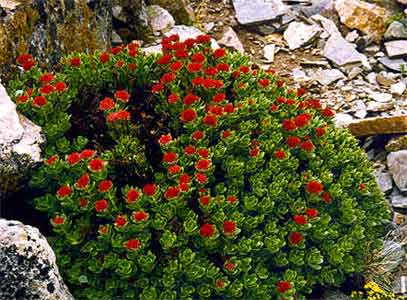
RHODIOLA
(Rhodiola rosea, R. kirilowii, R. crenulata)
Rhodiola has been used by Tibetans as a traditional remedy for more than 1000 years. Today, it is popular around the world, used as an adaptogen. Adaptogens are defined as substances that have no toxicity or side effects at normal dosages and that non-specifically increases the body's resistance to disease and to physical and chemical stresses.
Rhodiola has been used by Tibetan doctors in formulas to treat dysentery, back pain, lung inflammation, painful and irregular menstruation, leukorrhea, epidemic diseases, limb edema, traumatic injury, and to heal burns. According to Chinese interpretation, rhodiola can support vital energy (qi), help the body resist pathogens, enrich the blood, nourish the brain, improve intelligence, and preserve health.
Recently, various preparations of rhodiola, alone or compounded into prescriptions, have been produced and used in clinical practice to prevent and treat various diseases. The rhodiola preparations have been shown the following effects: to reinforce physical strength, enhance body endurance, compensate for low oxygen, relieve tiredness and weakness, improve efficiency of physical and mental work, treat cardiac and pulmonary diseases, and counteract side-effects of chemotherapy and radiotherapy for cancers. In the clinical studies, rhodiola was evidently effective for treating weakness, poor appetite, heart palpitations, dizziness, chest distress and insomnia. The herb could also increase blood levels of hemoglobin and platelets and reduce the heart rate. After rhodiola was used to treat patients with coronary heart disease, attacks of angina pectoris were relieved along with the partial blood oxygen pressure of the arteries and arterial blood oxygen saturation was elevated.
One of the adaptogenic applications of rhodiola that has received considerable research attention is for aiding adaptation to high altitudes, thus, as a preventive and treatment for mountain sickness. Perhaps by related mechanisms, rhodiola has been shown to significantly aid athletic performance and to delay fatigue by improving oxygen utilization during exercise. Researchers speculate that rhodiola also helps reduce the stress that occurs secondary to exercise by regulating the parasympathetic nervous system, normalizing the body functions more rapidly after vigorous exercise.
In pharmacology experiments, rhodiola, has been found to inhibit the production of lipid peroxide in liver cells, an antiaging function. It can also enhance the activity of serum SOD (a natural anti-oxidant), clear free radicals, and improve activity of cells, which also have antiaging potential. These properties have also been demonstrated for green tea. The combination of green tea and rhodiola is of potential value in normalizing the blood content of lipids, glucose, and hemoglobin, and calming nervousness, while helping to overcome fatigue.